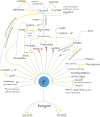Chemical-Assisted Microbially Mediated Chromium (Cr) (VI) Reduction Under the Influence of Various Electron Donors, Redox Mediators, and Other Additives: An Outlook on Enhanced Cr(VI) Removal
- PMID: 33584585
- PMCID: PMC7875889
- DOI: 10.3389/fmicb.2020.619766
Chemical-Assisted Microbially Mediated Chromium (Cr) (VI) Reduction Under the Influence of Various Electron Donors, Redox Mediators, and Other Additives: An Outlook on Enhanced Cr(VI) Removal
Abstract
Chromium (Cr) (VI) is a well-known toxin to all types of biological organisms. Over the past few decades, many investigators have employed numerous bioprocesses to neutralize the toxic effects of Cr(VI). One of the main process for its treatment is bioreduction into Cr(III). Key to this process is the ability of microbial enzymes, which facilitate the transfer of electrons into the high valence state of the metal that acts as an electron acceptor. Many underlying previous efforts have stressed on the use of different external organic and inorganic substances as electron donors to promote Cr(VI) reduction process by different microorganisms. The use of various redox mediators enabled electron transport facility for extracellular Cr(VI) reduction and accelerated the reaction. Also, many chemicals have employed diverse roles to improve the Cr(VI) reduction process in different microorganisms. The application of aforementioned materials at the contaminated systems has offered a variety of influence on Cr(VI) bioremediation by altering microbial community structures and functions and redox environment. The collective insights suggest that the knowledge of appropriate implementation of suitable nutrients can strongly inspire the Cr(VI) reduction rate and efficiency. However, a comprehensive information on such substances and their roles and biochemical pathways in different microorganisms remains elusive. In this regard, our review sheds light on the contributions of various chemicals as electron donors, redox mediators, cofactors, etc., on microbial Cr(VI) reduction for enhanced treatment practices.
Keywords: Cr(VI) reduction; chemical-assisted; electron donors; electron mediators; microbially mediated process.
Copyright © 2021 Rahman and Thomas.
Conflict of interest statement
The authors declare that the research was conducted in the absence of any commercial or financial relationships that could be construed as a potential conflict of interest.
Figures




Similar articles
-
Formation mechanism of organo-chromium (III) complexes from bioreduction of chromium (VI) by Aeromonas hydrophila.Environ Int. 2019 Aug;129:86-94. doi: 10.1016/j.envint.2019.05.016. Epub 2019 May 20. Environ Int. 2019. PMID: 31121519
-
Bacteria-driven copper redox reaction coupled electron transfer from Cr(VI) to Cr(III): A new and alternate mechanism of Cr(VI) bioreduction.J Hazard Mater. 2024 Jan 5;461:132485. doi: 10.1016/j.jhazmat.2023.132485. Epub 2023 Sep 9. J Hazard Mater. 2024. PMID: 37714006
-
Effects of sludge lysate for Cr(VI) bioreduction and analysis of bioaugmentation mechanism of sludge humic acid.Environ Sci Pollut Res Int. 2019 Feb;26(5):5065-5075. doi: 10.1007/s11356-018-3917-7. Epub 2019 Jan 3. Environ Sci Pollut Res Int. 2019. PMID: 30604364
-
Chromium-microorganism interactions in soils: remediation implications.Rev Environ Contam Toxicol. 2003;178:93-164. doi: 10.1007/0-387-21728-2_4. Rev Environ Contam Toxicol. 2003. PMID: 12868782 Review.
-
Mechanisms of hexavalent chromium resistance and removal by microorganisms.Rev Environ Contam Toxicol. 2015;233:45-69. doi: 10.1007/978-3-319-10479-9_2. Rev Environ Contam Toxicol. 2015. PMID: 25367133 Review.
Cited by
-
Novel "on-off" fluorescence sensing for rapid and accurate determination of Cr3+ based on g-CNQDs.RSC Adv. 2023 Sep 28;13(41):28550-28559. doi: 10.1039/d3ra05091b. eCollection 2023 Sep 26. RSC Adv. 2023. PMID: 37780737 Free PMC article.
-
Deciphering chromate tolerance and reduction ability of an indigenous Bacillus strain isolated from polluted pond sludge for chromium bioremediation.Sci Rep. 2025 Jul 2;15(1):23323. doi: 10.1038/s41598-025-07031-4. Sci Rep. 2025. PMID: 40603995 Free PMC article.
-
Phycoremediation mechanisms of heavy metals using living green microalgae: physicochemical and molecular approaches for enhancing selectivity and removal capacity.Heliyon. 2021 Jul 16;7(7):e07609. doi: 10.1016/j.heliyon.2021.e07609. eCollection 2021 Jul. Heliyon. 2021. PMID: 34355100 Free PMC article. Review.
-
Influencing factors and mechanism of Cr(VI) reduction by facultative anaerobic Exiguobacterium sp. PY14.Front Microbiol. 2023 Aug 10;14:1242410. doi: 10.3389/fmicb.2023.1242410. eCollection 2023. Front Microbiol. 2023. PMID: 37637125 Free PMC article.
-
Metagenomic Analysis Reveals Microbial Interactions at the Biocathode of a Bioelectrochemical System Capable of Simultaneous Trichloroethylene and Cr(VI) Reduction.Front Microbiol. 2021 Sep 30;12:747670. doi: 10.3389/fmicb.2021.747670. eCollection 2021. Front Microbiol. 2021. PMID: 34659183 Free PMC article.
References
-
- Ackerley D. F., Gonzalez C. F., Keyhan M., Blake R., Matin A. (2004). Mechanism of chromate reduction by the Escherichia coli protein, NfsA, and the role of different chromate reductases in minimizing oxidative stress during chromate reduction. Environ. Microbiol. 6 851–860. 10.1111/j.1462-2920.2004.00639.x - DOI - PubMed
-
- Alam M. Z., Ahmad S. (2012). Toxic chromate reduction by resistant and sensitive bacteria isolated from tannery effluent contaminated soil. Ann. Microbiol. 62 113–121. 10.1007/s13213-011-0235-4 - DOI
Publication types
LinkOut - more resources
Full Text Sources
Other Literature Sources
Miscellaneous

